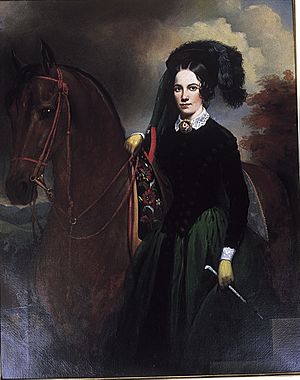Belmont Mansion (Tennessee) facts for kids
Quick facts for kids |
|
|
Belmont
|
|

Belmont Mansion
|
|
| Location | 1900 Belmont Boulevard Nashville, Tennessee |
|---|---|
| Built | 1849–1853 |
| Architect | William Strickland or Adolphus Heiman |
| Architectural style | Greek Revival, Italianate |
| NRHP reference No. | 71000816 |
| Added to NRHP | May 6, 1971 |
Belmont Mansion, also known as Acklen Hall, was once a grand summer home. It was originally called Belle Monte or Belle Mont. This historic mansion is located in Nashville, Tennessee. It was built between 1849 and 1853 by a very wealthy couple, Joseph and Adelicia Acklen. They used money from their large cotton farms, which were worked by enslaved people. The mansion was the center of their huge 180-acre country estate. It featured beautiful gardens and even a zoo!
The Acklens lived at Belmont during the summer months. For the rest of the year, they stayed on their cotton farms in Louisiana. In the late 1800s, the estate was sold. Since 1890, it has been used for education. It started as a girls' school, then became part of what is now Belmont University. Today, Belmont Mansion is a museum. It was added to the National Register of Historic Places in 1971.
Contents
Discovering Belmont Mansion's History
How Belmont Mansion Was Built
In 1849, Adelicia Franklin became a very rich widow. Her first husband, Isaac Franklin, had left her a large fortune. She then married Joseph Alexander Smith Acklen, a young lawyer. Together, they started building Belle Monte, which means "beautiful mountain."
The mansion was built on 180 acres of land near Nashville. It was finished in 1853 and designed in the Italian villa style. Adelicia and Joseph used Belmont as their summer home. They spent the rest of the year on their seven large cotton farms in Louisiana. These farms covered about 8,600 acres.
A Grand Home with Many Rooms
Belmont Mansion was one of the most impressive homes in the South before the American Civil War. It had 36 rooms and covered 19,000 square feet. The main house sat on top of a hill. It had covered balconies with fancy iron railings. These balconies helped keep the sun out of the windows.
On top of the house was a ten-foot-tall, eight-sided tower called a cupola. This cupola helped cool the house in summer. It was also used as an "astronomical observatory." From here, the family could look at the stars, their estate, and even downtown Nashville.
Special Buildings and Gardens
Next to the main house was a T-shaped building. This building served as a guest house and an art gallery. The south part of the guest house had rooms for visitors and a bowling alley. The art gallery, in the north part, had a special glass roof.
The grounds around the mansion were amazing. They included beautiful gardens, greenhouses, and an aviary (a place for birds). There was also a lake and a zoo! The greenhouses grew tropical fruits and flowers. You could find camellias, jasmine, lilies, and cacti there. The zoo had bears, monkeys, peacocks, and even alligators from Louisiana. There was also a special park for deer.
Family Life and the Civil War
Joseph and Adelicia had six children together. Sadly, their twin babies died from scarlet fever in 1855. In 1863, Joseph passed away in Louisiana. He was there looking after their farms during the American Civil War.
During the war, Adelicia made secret deals. She worked with both Union and Confederate leaders. This allowed her to ship 2,800 bales of cotton to England. She sold them for a lot of money, about $758,000.
In December 1864, Union soldiers camped on the mansion's grounds. This was before the Battle of Nashville. About 13,000 troops stayed there for two weeks. The grounds were damaged a bit, but Belmont Mansion itself and its valuable contents were safe.
After the War: Art and Education
Right after the war, Adelicia and her four children traveled to Europe. While there, she bought many beautiful artworks. She collected five large marble statues by famous American artists working in Rome. Four of these statues are still in the mansion today. In France, Adelicia even met Emperor Louis Napoleon and Empress Eugénie.
A few months before she died, Adelicia sold Belmont and its land. It was bought by Lewis T. Baxter for about $54,000. In 1890, the mansion became a women's academy and junior college. The school later merged with another and was renamed Ward-Belmont in 1913.
In 1951, the Tennessee Baptist Convention bought the school. They created a four-year college called Belmont College. This college grew into Belmont University, which offers many different programs today. In 2007, Belmont University became independent from the Tennessee Baptist Convention.
Today, Belmont Mansion is owned by the Belmont Mansion Association and Belmont University. The Belmont Mansion Association takes care of it and runs it as a museum.
What You Can See Today
Inside the mansion, you can still see many original features. Gilded mirrors hang over marble fireplaces. They reflect the fancy gas lights and beautifully furnished rooms. Much of the original Venetian glass is still in the windows and doors. The Grand Salon is thought to be the most detailed home interior built in Tennessee before the Civil War.
The gardens, now part of the university campus, have five cast iron gazebos. The 105-foot water tower is also still on the grounds. Today, it serves as a Bell Tower for Belmont University.
Many important people visited Belmont Mansion over the years. These guests included Mrs. James K. Polk, William Walker, and Thomas Huxley.
Belmont Mansion was added to the National Register of Historic Places in 1971.
See Also
- Fairvue Plantation (Gallatin, Tennessee) - Another historic home connected to Adelicia Acklen.
- Louisiana State Penitentiary - This prison was formed on land that once belonged to Isaac Franklin's plantations.





